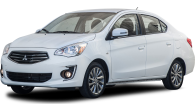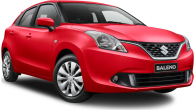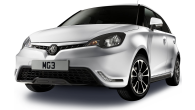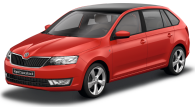If your heart is set on buying a brand new car, and your bank account won’t stretch any further than $15,000 before on roads, you’re in luck – there are around 11 micro and light cars that you can buy right now – but not one of them is a Toyota.
Fear not, though – you’ll only have to find another $290 to get into Toyota’s cheapest passenger car, the Yaris Ascent. Oh, wait… you want an auto? Well, that’ll be another $1350, please…
Still, a brand new Toyota for $16,820 before on roads isn’t a bad deal. Is it? It's certainly motoring at its most basic, but is it good value for money?
.jpg)
Toyota Yaris 2017: Ascent
| Engine Type | Inline 4, 1.3L |
|---|---|
| Fuel Type | Unleaded Petrol |
| Fuel Efficiency | 5.8L/100km (combined) |
| Seating | 5 |
| Price From | $10,340 - $14,190 |
| Safety Rating |
|
Is there anything interesting about its design?
7 / 10
Toyota has recently updated the Yaris – which debuted here in 2005 – with a new sculpted bonnet and bumper treatment and intricate headlight and tail-light detail, setting it apart from the small car pack.
Inside the sculpted, multi-layered dashboard treatment and flat-faced dash and console stays pretty much the same, scoring a squirt of piano lacquer black in place of silver around the multimedia unit, in the steering wheel and around the gear shifter.
.jpg)
Its entry level origins aren’t hard to pick – the 15-inch steel wheels with hubcabs give the game away pretty quickly.
How practical is the space inside?
7 / 10
Built as a five-seater, the small Yaris five-door hatch is surprisingly adaptable from behind the wheel, with plenty of visibility, easy-to-read controls, and a steering wheel that's easily adjustable for both reach and height (though the reach is a little short).
A small touchscreen multimedia system, that appears in pretty much any current Toyota you care to name, controls functions like audio, Bluetooth, phone streaming and radio. No satellite navigation, Apple Car Play or Android Auto, sorry.
.jpg)
There are climate control dials instead of buttons, and the Ascent misses out on little nice-to-have features like one-touch indicators and a digital speedo.
The polyurethane steering wheel features controls for audio and phone, and basic cruise control is standard, as well. The exterior mirrors are electric, while the driver's window offers an auto-up function.
Our tester is outfitted with Toyota’s new optional Safety Sense package, which includes AEB, lane departure warning and automatic high beam control for $650. Oddly, though, the buttons that enable the systems are randomly scattered across the length of the dash.
The high-beam system, unfortunately, is a bit of a dud. While in auto beam mode, the system is unable to pick up oncoming headlights quickly enough, and the lights simply won't switch up to high beam if there is even the hint of light alongside even a darkened road.
.jpg)
For rear seat passengers, it’s a pretty basic story in the Ascent, with good headroom but not a lot of knee and toe room if taller people are in the front. The middle sash belt retracts into the roof, too, making it a bit difficult to access.
There are ISOFIX baby seat mounting points on both outside rear seats, but there are no cupholders or bottle holders in any form for rear seat passengers, apart from one cup-shaped receptacle between the front seats.
There’s a pair of side-by-side cupholders up front, along with a couple of shallow pockets in between the front seats, thanks to the lack of a centre console bin.
They are not very deep, though, and don't hold items particularly securely. The front doors do have bottle holders, along with small pockets.
.jpg)
The rear hatch measures out at 206 litres with the seats up, and there is a false floor that that allows you to hide smaller belongings out of sight underneath, or create a flat loading area when the 60/40 split fold seats are lowered.
There is a space-saver spare underneath the floor, as well.
.jpg)
Size-wise, rivals like the Kia Picanto, which sports 255 litres, and the Mitsubishi Mirage, which can carry 235 litres, outgun the Yaris.

Does it represent good value for the price? What features does it come with?
6 / 10
For $16,820 for the auto, the Yaris is priced relatively well in a class that contains cars like the Mazda2, Holden Spark and the Honda Jazz.
It comes with auto headlights but not auto wipers, cruise control, electric windows, basic climate control, a single USB port, a 12 volt socket, and dark cloth trim.
The driver’s seat base can be adjusted for height on the rear of the base, as well.
What are the key stats for the engine and transmission?
6 / 10
The cheapest Yaris uses a 1.3-litre all-alloy four-cylinder petrol engine that’s good for 63kW/120Nm. Fitted with Toyota’s variable valve timing system and a steel timing chain, the 2NZ-FE is less powerful than the 1.5-litre engine in the next model up, the SX, to the tune of 17kW/21Nm.
.jpg)
It’s backed in this case by a four-speed auto, which really is as old-fashioned as it sounds. Other cars in the category like the Mazda2 Neo can be optioned with a six-speed auto, which is a far more usable device when teamed with a small capacity, small output engine.
How much fuel does it consume?
7 / 10
Toyota claims a fuel consumption figure of 6.4 litres per 100km on the combined fuel economy cycle, and over a test period of 160 kilometres we recorded an average of 7.7L/100km.
The Yaris will drink 91RON without a drama, while its modest 42-litre fuel tank equates to a range of about 700km between refills.
What's it like to drive?
6 / 10
Weighing in a smidge over 1000kg, the Yaris gives its relatively small engine a fighting chance, but when it’s backed by just four widely spaced gear ratios, it’s always going to be a bit of a struggle.
There’s a lot of unnecessary and thoroughly tiring engine revving when pulling away from rest, and downshifts into lower gears also give the 1.3 a workout.
While it’s acceptable dynamically, there’s an underlying sense that Toyota’s crack suspension team hasn’t spent a lot of time worrying about the kinematics of the Yaris. It steers and stops well, and doesn’t upset its passengers at 50-80km/h, but ask any more of it, and it quickly lets you know that’s not part of its brief.
Tyre roar from the 15-inch Bridgestones also becomes an issue as speeds increase.
Warranty & Safety Rating
What safety equipment is fitted? What safety rating?
7 / 10
Even this most basic Yaris has seven airbags and a reversing camera as standard, helping it to achieve a maximum five-star ANCAP rating.
The optional 'Smart Sense' kit, which adds forward collision prevention and lane departure warning as well as that sketchy auto high beam system, is a $650 option.
As mentioned, buttons to control the optional safety system are scattered at random around the cabin, which makes them less easy to use.
For example, the lane departure warning system uses beeps instead of vibrations or light indications, which is quite irritating, and with the switch within easy reach, it's too tempting just to turn it off.
Likewise, the addition of the automatic high beam headlights really isn't worth the price of admission, given their poor performance in our testing.
Regardless, the addition of AEB is worth the price of admission – see how hard you can push your dealer when it comes time to sign the paperwork for a deal, though.
What does it cost to own? What warranty is offered?
7 / 10
A three-year/100,000km warranty is offered with the Yaris, which is shorter in both time and distance than many of its competitors.
Its six-month/10,000km service intervals are reflective of the pattern of use of a small city car, and are offset by its relatively low fixed price servicing program.
Over three years, the Yaris should cost around $840 to maintain through a Toyota dealer.
Verdict
The Yaris Ascent is right in the $15k car mix, and offers up a package that is better in some respect but trails its rivals in others.
While the bold design holds its own on the road, it doesn’t disguise the fact that the mechanicals of the Yaris are starting to date – the gearbox, for example, has been in use for 17 years now.
For the money, though, you’re buying something Toyota’s rivals simply don’t have – a sterling reputation for reliability and resale, which really adds that extra little something to the mix.
Pricing Guides



.jpg)





































.jpg)

.jpg)



